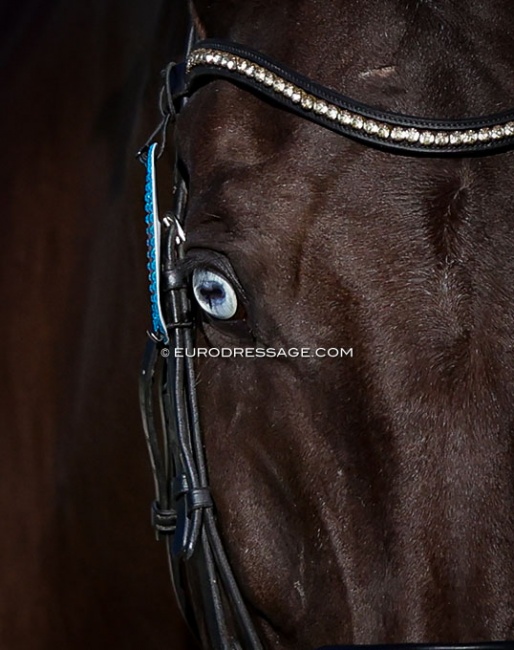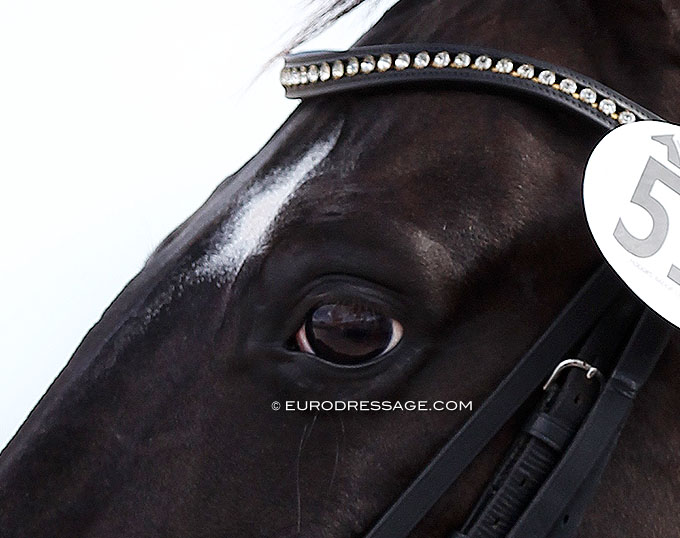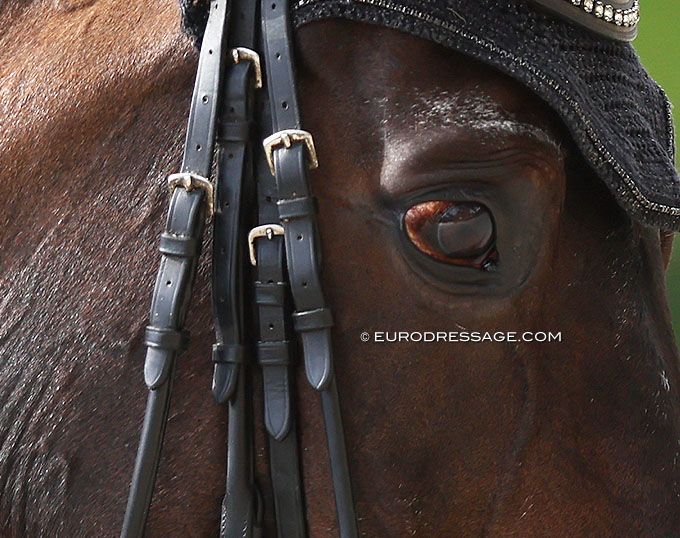
-- by Niina Kirjorinne for Eurodressage
Vision has many physiological and psychological effects on the balance and the movement of a horse. When the movement is confident, it looks easy, fluent, and powerful. Vision is essential for the movement to be coordinated and balanced. The information we get from the visual system needs to be accurate, and for this reason it’s important to be able to use the vision freely. The vision helps us to use our body and coordinate in the space and we prefer to see where we are and what we do.
Optic nerves connect the horse's eyes to the brain and to the central nervous system. Vision is also directly linked into the vestibular system, which is a highly important sensory system located in the inner ear. Eyes give the vestibular system sensory input, and the brain translates the information into motor output which is movement. The vestibular system is important for sensing, monitoring, and adjusting the head and body posture, movement, and eye position together with the support of proprioception and other mechanisms.
The image of the world we see around us while we move seems stabile and clear because of small, automatically coordinated movements of the eyes, head, and neck. These corrections are so small, that we don’t notice them ourselves, but if there is a lot of tension or something else blocking the function, it affects these systems. To move easily, you should be able to use the body, including vision, freely. If you struggle to see, you are not able to perform with your whole capacity. To reach towards optimal balance and confidence in the movement, you need to see where you are going.
Vision guides the movement
Good quality of movement is created from a good balance. Balance in turn helps the movement to become easy, energy efficient and confident.
For a good balance, we need many well functioning systems and one of the main keys to an optimal balance is accurate information from the horse’s eyes to the vestibular system which guides the whole way of moving. So, if you want to create elastic, balanced and powerful uphill movement, make sure the horse can use the whole capacity of his visual system.
Eye Rotation

If the horse’s head and neck position is natural and slightly open – the nose on or in front of the vertical – the eye can rotate and remain horizontal to collect important input information for the balance system.
When the head and neck position is extreme, no matter if up in the air or behind the vertical, the horse’s ability to look forward, using the area of binocular vision, is restricted, (for example when the nasal plane points backwards towards the ground) and while this happens, the eye can’t maintain its preferable horizontal position. He is then trying to maintain the balance based on restricted information which is making it very hard for the horse to use the whole capacity of the balance.
This creates tension and various individual compensations that again affect the balance – so it’s a vicious circle.
When You See White
You may have seen some horses moving in a closed frame with very tense, “concerned” eyes, with white areas visible on the “back side” of the eye. This kind of expression can appear for many reasons, but it’s important to understand that one reason can be that the horse struggles to see and the pupil is trying to achieve the horizontal position. In some head and neck postures this becomes very difficult or even impossible due to anatomical reasons.

Try This Yourself
Look straight ahead and pick a spot to look at in front of you: focus and keep your sight there. Drop your chin down (towards your chest). Let the chin down but keep your eyes on the spot you chose to look at. Keep this position for a short while. How does this feel and where? For how long do you feel comfortable to hold this position? And what happens if you try to move like this? (Caution - If you try to walk or move when doing this, please be careful, as this can make you dizzy).
Do you feel like getting accurate information for your balance system by using your vision like this? By trying this exercise, we can partly simulate what the horse might experience when trying to look forward in a closed frame.
I hope the future research will bring us deeper understanding about the relation of equine vision and the effects of head and neck postures we see being routinely used on horses. There is already a lot of good information and research available around the topic.
-- by Niina Kirjorinne for Eurodressage
Sources and further reading:
Why do animal eyes have pupils of different shapes?
Martin S Banks, William W Sprague, Jürgen Schmoll, Jared A Q Parnell, Gordon D Love (2015)
https://www.science.org/doi/10.1126/sciadv.1500391
Equine vision
Miller, P. E., & Murphy, C. J. (2016). Equine Ophthalmology, 508–544.
https://www.researchgate.net/publication/280090679
Over-flexing the horse’s neck: A modern equestrian obsession?
McGreevy, P. D., Harman, A., McLean, A., & Hawson, L. (2010). Journal of Veterinary Behavior: Clinical Applications and Research, 5(4), 180–186. https://www.researchgate.net/publication/248578106
Book Equine Neurology, Martin Furr, Stephen Reed, Wiley Blackwell 2nd Edition 2015